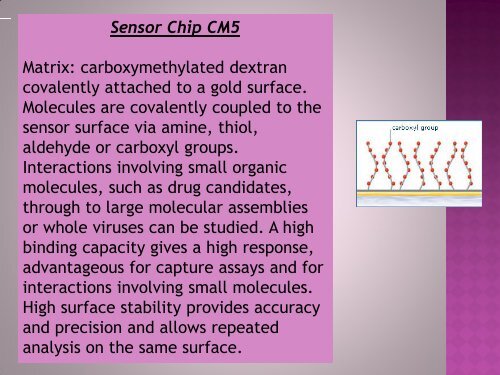Capitolo 11 - Omero
Capitolo 11 - Omero Capitolo 11 - Omero
Le analisi constano di due fasi fondamentali: l’immobilizzazione del ligando sul sensor chip, e lo studio vero e proprio dell’interazione ligando-analita. Immobilizzazione del ligando La fase in cui il LIGANDO viene immobilizzato sulla superficie del chip viene detta COUPLING. Le reazioni chimiche coinvolte nel processo di immobilizzazione del ligando sul chip CM5, che è rappresentato da tre eventi fondamentali: ‣ 1. ATTIVAZIONE: i gruppi carbossilici vengono attivati chimicamente tramite N-etil-N’-(3 dimetilaminopropil) carbodimide cloridrato (EDC) e N-idrossisuccinimmide (NHS). ‣ 2. COUPLING: il ligando reagisce coi gruppi carbossilici attivati della matrice. I gruppi funzionali della molecola di ligando coinvolto in questa reazione possono essere diversi, nel caso delle proteine si forma un legame amidico con i gruppi amminici degli amminoacidi basici (AMINE COUPLING). ‣ 3. INATTIVAZIONE: la succinimmide che non ha reagito con il ligando viene sostituita con ETANOLAMINA.
Sensor Chip CM5 Matrix: carboxymethylated dextran covalently attached to a gold surface. Molecules are covalently coupled to the sensor surface via amine, thiol, aldehyde or carboxyl groups. Interactions involving small organic molecules, such as drug candidates, through to large molecular assemblies or whole viruses can be studied. A high binding capacity gives a high response, advantageous for capture assays and for interactions involving small molecules. High surface stability provides accuracy and precision and allows repeated analysis on the same surface.
- Page 2 and 3: Una tecnica innovativa per lo studi
- Page 4: La strumentazione è costituita da
- Page 7 and 8: Sensor Chip
- Page 9 and 10: Il sensor chip presenta quattro cel
- Page 12 and 13: La sorgente luminosa del sistema an
- Page 14 and 15: IFC
- Page 16 and 17: Principio teorico della surface pla
- Page 19 and 20: L'angolo al quale si osserva questo
- Page 24 and 25: Sensor Chip L1 Matrix: lipophilic g
- Page 27 and 28: In genere per ogni esperimento veng
- Page 29: Studio dell’interazione antigene-
- Page 32: Studio dell’interazione proteina-
- Page 35 and 36: Protein interactions Investigate in
- Page 37: Cells and virus Study interactions
Sensor Chip CM5<br />
Matrix: carboxymethylated dextran<br />
covalently attached to a gold surface.<br />
Molecules are covalently coupled to the<br />
sensor surface via amine, thiol,<br />
aldehyde or carboxyl groups.<br />
Interactions involving small organic<br />
molecules, such as drug candidates,<br />
through to large molecular assemblies<br />
or whole viruses can be studied. A high<br />
binding capacity gives a high response,<br />
advantageous for capture assays and for<br />
interactions involving small molecules.<br />
High surface stability provides accuracy<br />
and precision and allows repeated<br />
analysis on the same surface.



